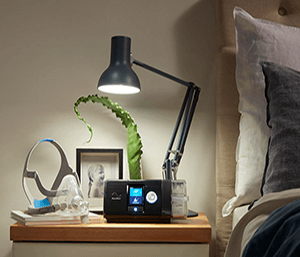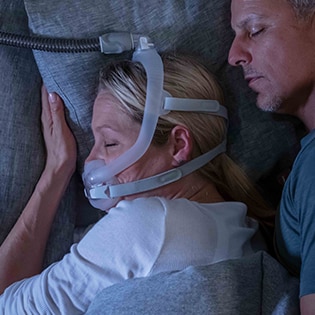How can I find the mask best suited to my face and lifestyle?
Just like people’s faces, masks come in different shapes and sizes.
Most masks fall into one of these categories:
- Nasal mask (covers your nose)
- Nasal pillows mask (sits at your nostrils)
- Full face mask (covers your mouth and nose)
Which mask is best for me?
It can take some time to work out which mask is best for you.
Making that decision can depend on how you breathe on treatment. For instance, do you breathe through your mouth rather than your nose, or do you tend to get a blocked nose?
If you know you have no problem breathing through your nose wearing a mask, you should be able to use a nasal mask or nasal pillows mask.
If you breathe through your mouth (sometimes referred to as ‘mouth breathing’), you can try a full face mask or a chin strap to stop your mouth from opening during sleep.
How to treat mouth leak
Mouth leak happens if you sleep with your mouth open, and air “leaks” out of your mouth during therapy.
Opening your mouth during sleep can either be out of habit, or it could be because your nose is blocked. Mouth leak can be very uncomfortable and leave you with a dry mouth. (It’s also very noisy; if it doesn’t wake you, it can wake your bed partner.)
If it happens every now and then, you might be able to stop it by wearing a chin strap to keep your mouth closed, or by using a humidifier to stop your nose getting blocked.
If mouth leak happens a lot, you may need to use a full face mask, which covers both your nose and mouth, so even if you breathe through your mouth while you sleep, air will not leak out.
Fitting your mask
The aim of getting a good mask fit is to achieve a stable seal (so that air does not leak out), without compromising your comfort.
If air is leaking out of your mask (mask leak) or your mouth (mouth leak) you won’t get the full benefits of therapy.
The best way to get a good seal is to fit the mask before connecting the tubing or turning on your therapy device. Putting the mask on with the air pressure turned on might crease or twist the cushion/pillows, which could create “leaks.”
Creases in the cushion/pillows can be very small and hard to feel, and most people tend to react by tightening the mask too much to get a good seal, which can be very uncomfortable. Over-tightening the mask can also lead to leaks and therefore should be avoided.
Once your mask is correctly positioned on your face, turn the air flow on. You may need to make minor adjustments with the device turned on to ensure you still have a good seal.
It’s normal to spend some time putting your mask on properly at first. You can use a mirror or ask someone to check if the cushion/pillows are positioned properly.
Incorrect fitting causes many of the problems people have with masks. Each mask type has a specific fitting sequence, so it’s best to follow the steps outlined in your user guide or videos.
The more you can get used to your mask the better. Practice putting it on, taking it off and detaching it from the tubing during the day, so that you feel confident about doing it at night, in the dark or when you’re half asleep!
It’s important to realise that you’re not expected to know how to fit your mask perfectly the first time. It takes time to perfect, and as you get used to your mask, you will find a way of fitting that works best for you.
And remember: if you’re having difficulty fitting your mask, your care provider is there to help you smooth out any issues.
Please also contact them if you’re finding it difficult to get a good seal; you might have the wrong mask or wrong size.
View our support page for more information on how to fit your mask.
Getting the right mask size
Your aim is to achieve a snug mask fit-not too loose and not too tight.
It’s hard to get a good seal and comfortable fit if you have the wrong mask size.
If you’re having issues with your mask, check your User Guide to make sure you’re fitting it correctly. Also, check for creases.
Many people fit more than one size. So if the mask is still leaking air (especially around the bridge of the nose for a nasal or full face mask) it might be worth trying a different mask size.
Don’t assume if you’re male you need a large mask size or if you’re female you need a small one. Your mask size depends on the key measurements of your face.
Here’s how to make sure you have the right mask size.
Is your mask making funny noises?
If your mask is making some burping or blurting sounds, it’s likely you have a leak. The best-fitting masks may still have some minor leaks, but there should generally be minimal leak from everywhere other than the vent. You can manage small leaks by working on your fitting technique. Check if you are fitting your mask correctly.
Is your mask leaving marks on your face?
If you often wake up with redness or marks on your skin from wearing the mask all night, try adjusting your mask so that you get a good seal but with less pressure on your face.
If that doesn’t work, here are some tips you can try:
- Check you have the right mask size.
- Some masks are available with soft wraps for the headgear straps and act as an extra defence against facial marks.
- Add a layer of padding between the cushion and your skin, with the Gecko nasal pads.
- If you use a nasal mask or nasal pillows mask, alternate between wearing the nasal mask (which covers your nose) and the nasal pillows mask (which sits at the entrance of your nostrils). This can ease the pressure on different parts of your face.
Refer to your user guide for troubleshooting tips that may help solve any issues around facial marks. If you have tried everything and you still have red marks on your face, contact your care provider or equipment supplier.
When your mask wears out
It’s important to clean your mask according to the guidelines in your User Guide, so that you can get the most performance out of your equipment, and ultimately, your therapy.
Some people also tend to stick with their old products rather than try newer ones.
If that’s you, you could be missing out on significant improvements and solutions to your therapy challenges. At ResMed, we are committed to continually improving our products, and packing them with features to keep you treated and comfortable.
Find out when and how to clean and replace your mask.
Managing ‘tube drag’
‘Tube drag’ is when your tube pulls on your mask and affects the seal, causing leaks.
If you don’t realise it’s happening, you can find yourself tightening the mask for the wrong reasons and causing more leaks.
Many masks are designed to manage a certain level of tube drag. With the device turned on, pull gently on the tube to find out what tube drag feels like.
Roll around a bit in bed to see if your tube gives you enough room to move, and how much tubing you actually need. Most masks have longer tubing available if you need it.
 Middle-East (English)
Middle-East (English) 



